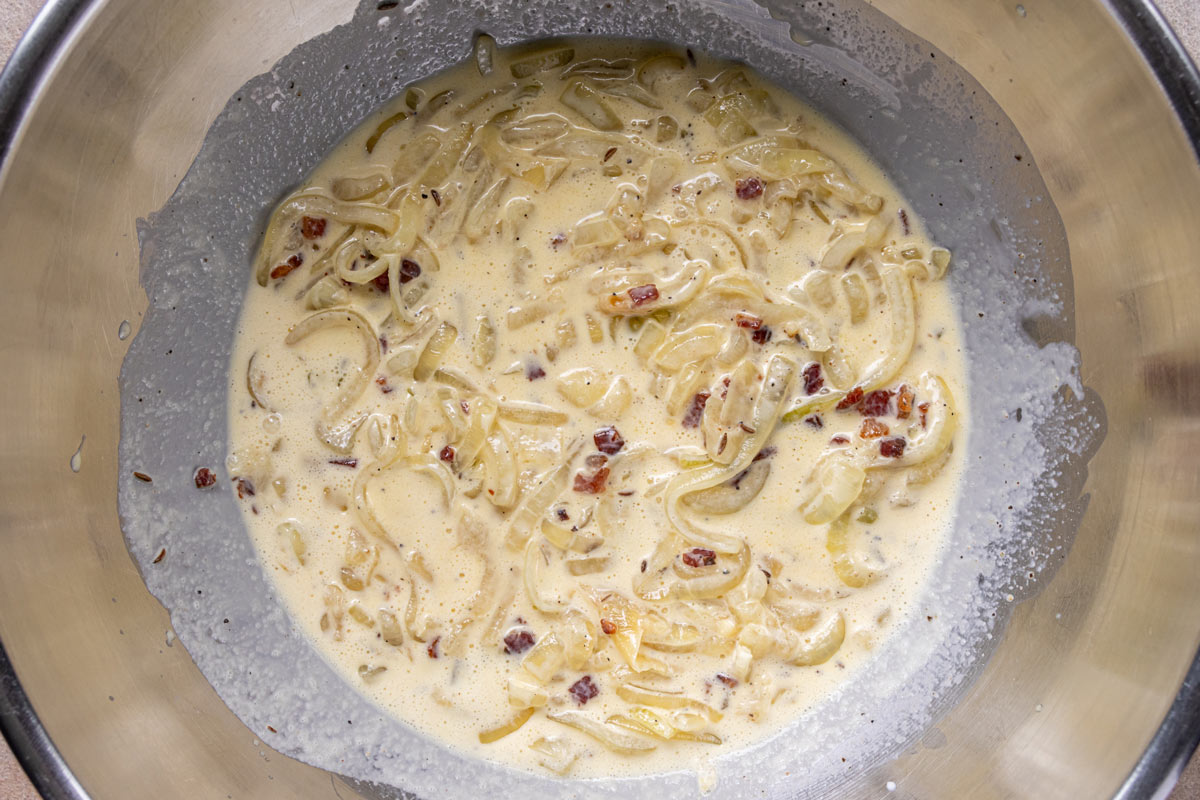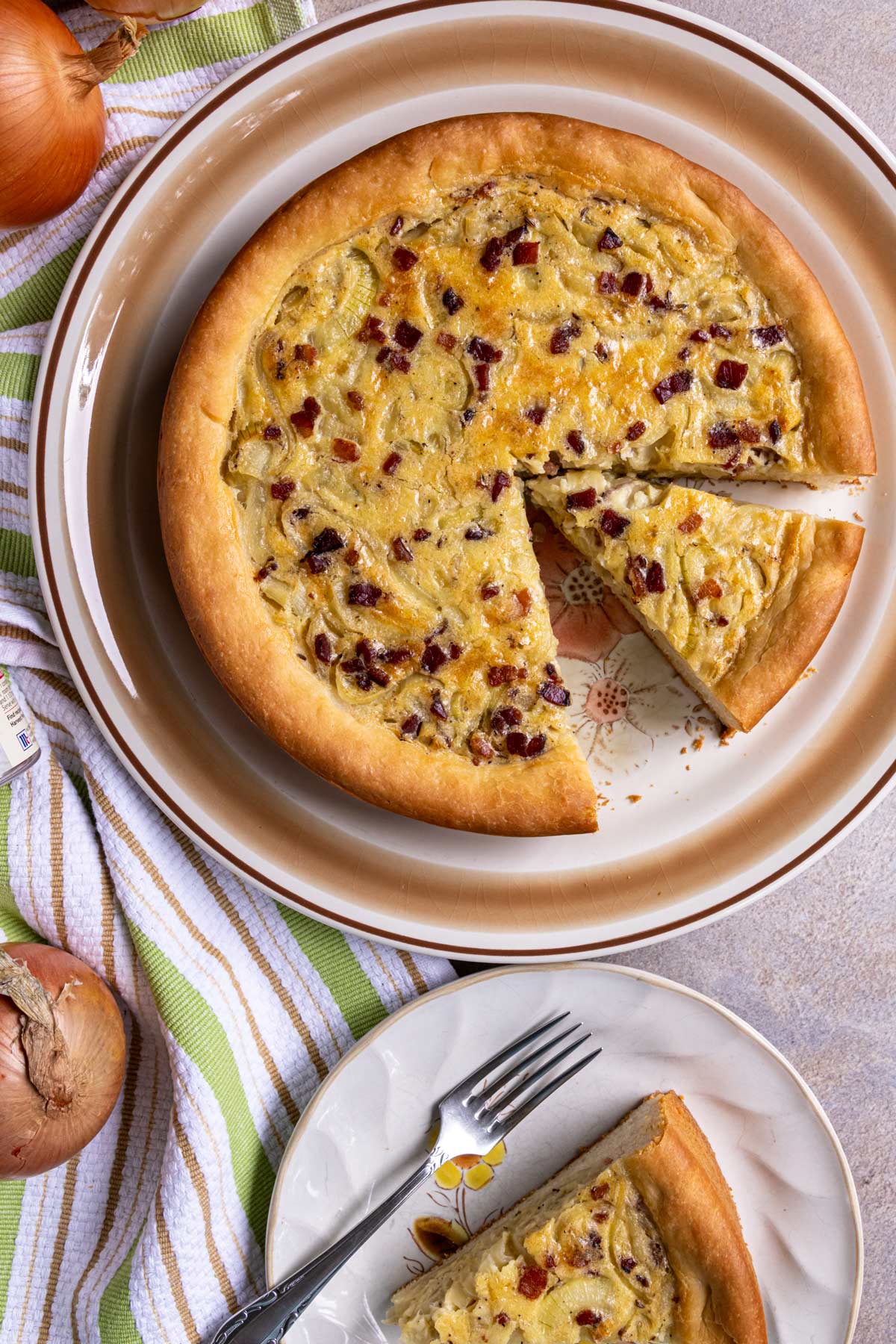Zwiebelkuchen is a savory German onion pie with a buttery yeasted dough crust and a filling of onions and bacon bound together in rich custard. While it has similarities to a quiche, it’s quite unique and a true German favorite.

Although zwiebelkuchen literally translates to “onion cake” in German, it’s really more of a savory onion pie. It’s almost like a hybrid between a deep dish pizza and a quiche, but flavorwise it has most in common with Flammkuchen, which is an Alsatian flatbread topped with onions and bacon.
Zwiebelkuchen is enjoyed year round, but is especially popular throughout the fall months in Southern Germany, which coincides with the annual grape harvest. Traditionally, it’s served with a glass of Federweißer or Federweisser, which is a young sweet wine or grape must, although you can certainly serve it with wine (or even German beer) as well!
There are many variations to the preparation and even shape of this beloved German onion pie, however Schwäbischer Zwiebelkuchen refers to this popular version from the Bavarian region of Swabia. This version is round and deep, similar to a quiche. Meanwhile, others can be flatter, baked in a square or rectangular pan, and cut into squares to serve.
The crust is a yeasted dough with a bit of richness from the addition of butter and milk. Meanwhile, the filling usually contains onions, bacon, eggs, and either sour cream or heavy cream. It sometimes includes caraway seeds as an optional addition, and often but not always has a little flour to help stabilize the filling.
Ingredient notes

- Crust: For traditional Schwäbischer Zwiebelkuchen, you’ll make an enriched yeast dough containing flour, yeast, butter, and milk. As a shortcut, you could use store-bought pizza dough or pie crust but both will provide slightly different results from the original homemade dough.
- Bacon: Use high-quality, thick cut bacon for the best results. I like to use the Black Forest thick cut bacon sold at the meat counter at Whole Foods.
- Onions: Brown or yellow onions work perfectly fine here, but you could really use any kind of onions you have on hand.
- Eggs: Eggs are key for creating the luscious custardy filling for zwiebelkuchen.
- Cream: You could use heavy cream or sour cream in the filling. One will be extra rich while the other will provide a bit of tang. You could also use a combination of the two!
- Flour: A bit of additional flour in the filling helps absorb excess moisture from the onions but even more importantly helps to stabilize the custard filling to help it set.
- Seasonings: Caraway seeds are optional here, but are a popular addition both for their flavor and their digestive properties. You can also add a pinch of nutmeg to the filling if desired. Salt and pepper are standard additions, of course.

How to make it
Begin by making the dough. In the bowl of an electric mixer fitted with the dough hook, combine yeast, sugar, and some warm milk. Let the mixture sit for about 5 minutes.
Add the remaining milk, flour, butter, and salt, and mix until the dough forms into a smooth ball, about 2 minutes.


Cover the bowl with plastic wrap or a tea towel and set it in a slightly warm, draft-free place to rise until nearly doubled in size, about 1 ½ to 2 hours.

To make the filling, add the bacon to a cold skillet and place it over medium heat. Cook until it renders most of its fat and becomes crispy, about 8 to 10 minutes.


Remove the cooked bacon to a bowl with a slotted spoon, leaving the bacon grease in the skillet.
If there’s a lot of bacon grease left in the skillet, remove some so you have about 2 tablespoons remaining to cook with. If there isn’t a lot, add some butter so you have about 2 tablespoons of fat in the pan.
In the skillet of bacon grease (and, if needed, butter), add the onions. Cook over medium heat until soft and translucent but not browned, about 10 to 12 minutes.


Stir in the flour and then set aside to cool.

In a mixing bowl, whisk together the eggs, heavy cream or sour cream, and the seasonings.


Stir in the cooked onion and flour mixture, and most of the cooked bacon. Reserve about 1 tablespoon bacon for the top.


Preheat the oven with the rack in the middle to 400°F (200°C).
Punch down the dough to deflate it and transfer to a 9-inch springform pan. Evenly press the dough into the bottom and up the sides of the springform pan. Use your fist to help push the dough up against the edges.

Pour the filling into the prepared crust. Sprinkle the reserved crispy bacon evenly over the top. Bake for 35 to 40 minutes until the crust is golden brown and the filling is set.


Remove from the oven and allow it to cool for about 10 minutes before removing from the pan and serving.
Zwiebelkuchen is best served warm but can also be eaten at room temperature or cold. For the most authentic experience, serve with chilled Federweißer or Riesling wine, or even a German lager if that’s your preferred libation.
Please scroll to the bottom of the post for the full recipe (in a printable recipe card) including ingredient amounts and detailed instructions.

Expert tips and FAQ
Store leftover German onion pie in an airtight container in the refrigerator for up to 3 days. You can either enjoy the leftovers cold, or warm them back up in the oven or toaster oven.
To freeze, slice zwiebelkuchen into portions and wrap each slice in plastic wrap (this will help prevent freezer burn if you freeze it longer). Then, transfer wrapped slices to a freezer safe container or large freezer bag. Freeze for up to 2 months. Thaw overnight in the fridge and then reheat in an oven or toaster oven before serving.
If you use a different type of pan other than a springform (such as a cake pan, or a square baking dish), line the bottom and sides with some parchment paper with overhang to allow you to easily remove the German onion pie from the pan to cut and serve.

Some regions in Germany add the raw, diced bacon to the filling rather than cooking it first. My preference is to cook the bacon until crispy before adding to the filling. I find it yields a much better flavor and textural experience.
I also like to cook the onions in the bacon fat. Some people cook the onions in butter alone, and just discard the fat from cooking the bacon. I think this is a great opportunity to develop even more yummy bacon flavor into the onions by using the drippings to cook them.
If you want to make this vegetarian, you can omit the bacon and cook the onions in 2 tablespoons of unsalted butter.
If your house is particularly cool or drafty, and you don’t have a warm spot to proof the dough, try this technique. Turn on your oven (at any temperature) for just 30 to 60 seconds or so. Turn it off the moment the oven feels slightly warm but not hot (just keep opening the door and checking). Then cover your dough and place it in the slightly warm oven and let it proof in there. This works great during winter months. On a warm summer day, regular room temperature should be sufficient.

Other recipes you may like
- Flammkuchen (German Pizza with Bacon and Onions)
- Himmel und Erde (German Heaven and Earth Potatoes)
- Kasnocken (Austrian Spaetzle with Cheese and Onions)
- Älplermagronen (Swiss Alpine Macaroni and Cheese)
- Bacon Jalapeño Popper Quiche
Tried this recipe? Please leave a star ⭐️⭐️⭐️⭐️⭐️ rating in the recipe card below and/or a review in the comments section further down the page. You can also follow me on social media on Facebook, Instagram, and Pinterest!

Zwiebelkuchen (German Onion Pie)
Ingredients
Dough:
- 3.5 grams (1 ⅛ teaspoons / ½ package) dry active yeast
- 1 teaspoon sugar
- ⅔ cup (155 ml) milk lukewarm–heated to about 100°F to 110°F (38°C to 43°C)
- 250 grams (2 cups) all-purpose flour
- 56 grams (4 tablespoons) unsalted butter room temperature
- 1 teaspoon kosher salt
Filling:
- 85 grams (3 ounces) thick-cut bacon diced or cut into ¼-inch thick matchsticks
- 455 grams (1 pound) onions peeled, halved, and thinly sliced
- 1 to 2 tablespoons unsalted butter (if needed)
- 1 tablespoon all-purpose flour
- 2 large eggs
- ½ cup heavy cream or full-fat sour cream
- 1 teaspoon kosher salt (or to taste)
- ½ teaspoon caraway seeds (optional)
- ¼ teaspoon ground black pepper
- Pinch grated nutmeg (optional)
Instructions
Dough:
- In the bowl of an electric mixer fitted with the dough hook, combine the yeast, sugar, and half the milk. Let the mixture sit for about 5 minutes for the yeast to bloom.
- Add the remaining milk, flour, butter, and salt, and mix on medium-low to medium speed until the dough forms into a smooth ball, about 2 minutes. Cover the bowl with plastic wrap or a tea towel and set it in a slightly warm, draft-free place to rise until nearly doubled in size, about 1 ½ to 2 hours.
Filling:
- Add the bacon to a cold skillet and place it over medium heat. Cook until it renders most of its fat and becomes crispy, about 8 to 10 minutes. Remove the cooked bacon to a bowl with a slotted spoon, leaving the bacon grease in the skillet.
- If there’s a lot of bacon grease left in the skillet, remove some so you have about 2 tablespoons remaining to cook with. If there isn’t a lot, add some butter so you have about 2 tablespoons of fat in the pan.
- In the skillet of bacon grease (and, if needed, butter), add the onions. Cook over medium heat until soft and translucent but not browned, about 10 to 12 minutes. Stir in the flour and then set aside to cool.
- In a mixing bowl, whisk together the eggs, heavy cream or sour cream, and the seasonings. Stir in the cooked onion and flour mixture, and most of the cooked bacon (reserve about 1 tablespoon for the top).
Assembly and Baking:
- Preheat the oven with the rack in the middle to 400°F (200°C).
- Punch down the dough to deflate it and transfer to a 9-inch springform pan. Evenly press the dough into the bottom and up the sides of the springform pan. Use your fist to help push the dough up against the edges.
- Pour the filling into the prepared crust. Sprinkle the reserved crispy bacon evenly over the top. Bake for 35 to 40 minutes until the crust is golden brown and the filling is set.
- Remove from the oven and allow it to cool for about 10 minutes before removing from the pan and serving. Zwiebelkuchen is best served warm but can also be eaten at room temperature or cold. For the most authentic experience, serve with chilled Federweißer or Riesling wine, or even a German lager if that’s your preferred libation.
Nutrition
*All nutritional information is based on third-party calculations and should be considered estimates. Actual nutritional content will vary with brands used, measuring methods, portion sizes and more.*






Comments
No Comments